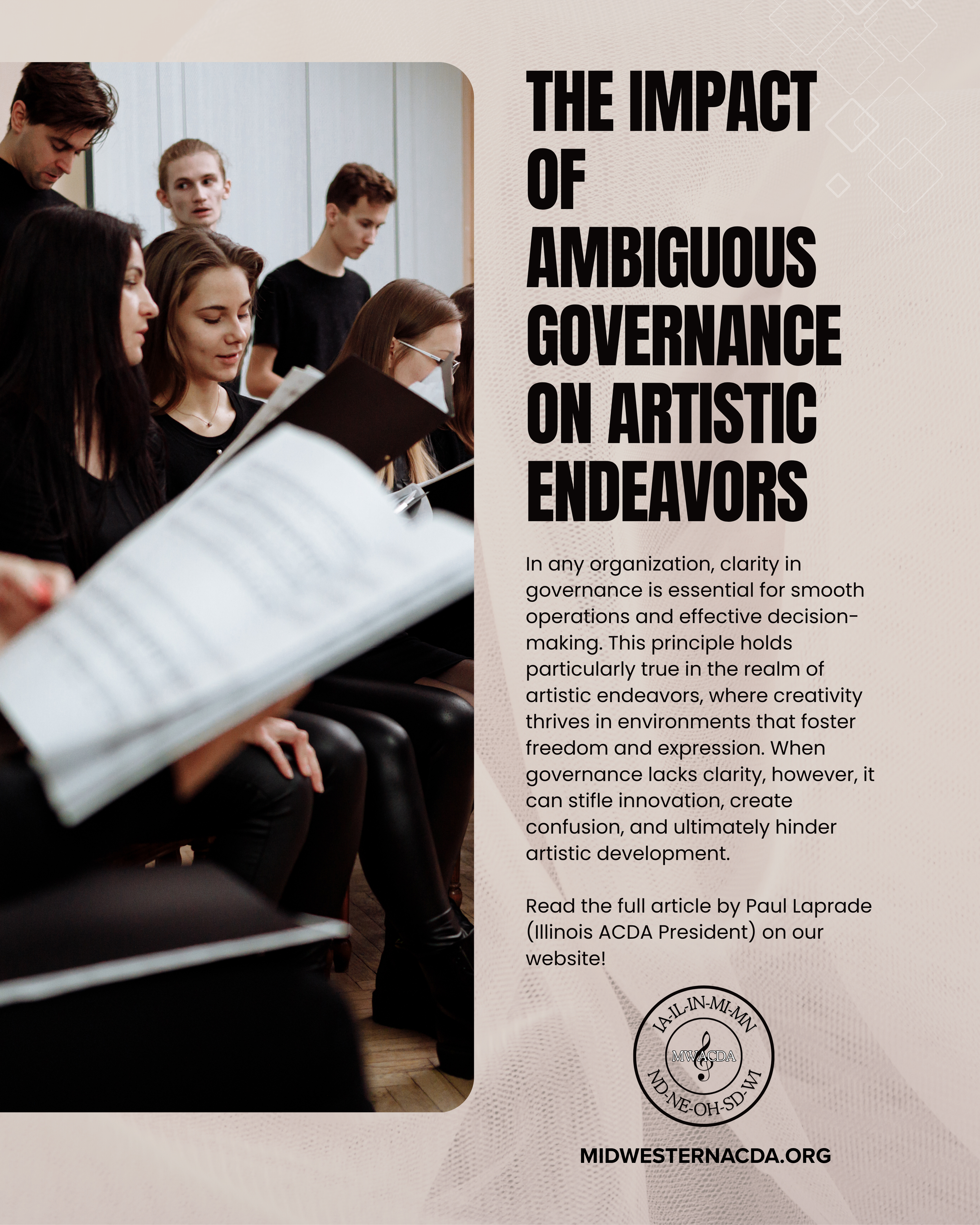
The Impact of Ambiguous Governance on Artistic Endeavors
Paul Laprade
President – Illinois ACDA
Greetings from Illinois-ACDA! Our organization has been enjoying the fruit of the efforts of our widely diverse membership. We have been providing renewed opportunities for various groups of singers, composers, and conductors; our renewal is in part a result of a need for reconsideration as a result of the changes we experienced after the pandemic, but is also the result of changes in the culture in which we seek to be relevant. As with any artistic organization, we have been looking inward to examine how our organization can be more
responsive to both our current and potential membership. This self-examination led us to a realization that our effectiveness has been hampered by a lack of clarity in our governance structure. In this short essay, I would like to share some of the principles that have guided our journey in the past year.
In any organization, clarity in governance is essential for smooth operations and effective decision-making. This principle holds particularly true in the realm of artistic endeavors, where creativity thrives in environments that foster freedom and expression. When governance lacks clarity, however, it can stifle innovation, create confusion, and ultimately hinder artistic development.
One of the primary ways that ambiguous governance interferes with artistic endeavors is through unclear roles and responsibilities. In our discipline, collaboration is key; singers, conductors, event organizers, and administrative boards must work together seamlessly. However, when governance structures are poorly defined, individuals may be uncertain about who is responsible for what. This can lead to overlapping duties or, conversely, critical tasks falling through the cracks. For example, if an organization lacks a clear decision making framework, an artist may find it difficult to secure necessary resources or approvals, leading to delays and frustration. When an organization has grown to rely on specific individuals to achieve or guide targets and projects, the roles and responsibilities may
become unclear or even convoluted when board positions eventually pass from one member to another. Perceived and actual inequity and questions with regard to organizational accessibility can arise in an environment in which unclear roles and responsibilities exist.
Moreover, ambiguous governance can breed a culture of hesitation or unnecessary compromise. In environments where artistic contributions are subject to vague guidelines or priorities that appear to shift with changing leadership, artists may feel compelled to self-censor or dilute their creative visions to align with perceived organizational expectations. This pressure to conform can stifle originality and lead to a homogenization of artistic expression, undermining the very essence of creative work. Input to discussions, or even one’s sense of involvement, can become diluted or even absent. When artists are unsure of how their contributions will be received or evaluated, they may avoid taking risks—essentially dimming the spark of innovation.
In the end, such a culture of hesitation can lead to a diminished level of engagement, and can impart an impression of limited accessibility and inclusion. If we are to promote diversity and equity in our organization, we must begin with ensuring that accessibility is not diminished by ambiguous governance. Additionally, lack of clarity in governance can hinder strategic planning and long-term vision. Projects such as conferences require significant investment in terms of time, resources, and collaboration. Without a clear governance framework to guide these efforts, we may struggle to articulate a cohesive vision that aligns with their artistic goals. This disconnect can result in fragmented initiatives that fail to build on one another, wasting valuable resources and talent. For instance, a lack of strategic direction may lead to the pursuit of fleeting trends rather than fostering a deeper engagement with the community or developing sustainable artistic practices. Although disconnected events can, in themselves, experience a degree of success and achievement, a choral organization is best when it envisions all of its events within a larger trajectory of a clearly-articulated vision. Furthermore, unclear governance can lead to conflicts among stakeholders–particularly harmful to an organization such as ours since collaboration is paramount.
Disagreements over vision, priorities, or resource allocation can escalate when an environment for conflict resolution or spirited discussion is not provided. This discord can create a toxic atmosphere that discourages collaboration and undermines the collective spirit vital for artistic innovation. Stating a clearly defined mission lies at the core of successful governance, as it provides a consistent benchmark against which decision-making—and discussion–are measured.
In conclusion, clarity in governance is crucial for nurturing creativity and artistic expression within any organization. While Illinois-ACDA has not experienced all of these challenges, our self-examination has led us to revise bylaws and clarify roles in a manner that we believe will help us thrive. We clearly defined roles within our governance structure in a manner that provides clarity; incoming board members apply for board positions with not only an understanding of our needs and expectations but also a well outlined description of what characteristics would make them successful in their prospective role. By establishing well-defined roles, fostering an open and supportive culture, and creating a strategic vision, we can empower our members to take risks, collaborate freely, and ultimately produce work that resonates deeply with audiences and our membership. In contrast, a lack of clarity can create barriers that stifle creativity and inhibit the very artistic growth in choral singing we strive to promote. By addressing governance issues, we remove many barriers to accessibility and inclusion, and achieve the goal of supporting opportunities in choral music for all we serve and will serve through ACDA.
We welcome you to visit our website, www.il-acda.org, to see many of the events we are planning and have recently offered. It is an honor to be a part of this fine division and work with you to promote the art of choral music.

